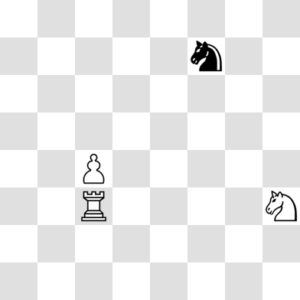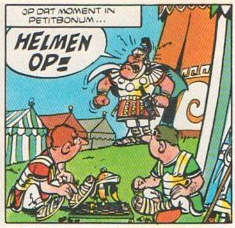Sic transit gloria mundi! There is no better way to summarise the fate of the Asterix series. It started all the way back in 1959 and quickly became one of the best and most popular series of Franco-Belgian comics. Until, in 1977, René Goscinny died. The quality nosedived immediately. The series muddled along in mediocrity for decennia, dipping deeply into awfulness with Asterix and the falling sky. But we don’t have to get into sad episode. Our topic for today is the fourth volume in the series, from Asterix‘ golden years in 1964.1
Uderzo’s drawings had more or less reached their final form by this point and Goscinny’s scenarios were bristling with wit. This particular volume starts with the tribune of Gallia looking for an original present for Julius Caesar. The twisted bulbs of his brain find no better solution than giving him one of the invincible Gauls from Asterix’ village. By the time the picture above appears, the Roman have reluctantly kidnapped the bard and have put him and the tribune on a ship to Rome. They are now dreading the repercussions of their action i.e. a Gaulish punitive expedition, which explains the centurion’s angry shout:
Armisurplus:2 Helmets on!
Of course, the preventive the measure the centurion so strongly suggests is of no protective use because, helmets or no, the Gauls are invincible. But it is very useful for Obelix’, who uses helmets to keep track of the number of Romans he knocked out.
But I’m getting distracted by the power of Goscinny. I should focus on the chessboard instead. The drawing is rather hard to make out, but that hasn’t stopped me before and it won’t stop me now:3
 The knight on h3 (which is possibly a6) is the only piece that be identified unambiguously. The piece on c3 seems to have a flat top, suggesting rather strongly that it is a rook. The one of c4 is even harder to classify, but it looks smaller than the one on f6, so it is probably a pawn.
The knight on h3 (which is possibly a6) is the only piece that be identified unambiguously. The piece on c3 seems to have a flat top, suggesting rather strongly that it is a rook. The one of c4 is even harder to classify, but it looks smaller than the one on f6, so it is probably a pawn.
Now, eagle-eyed readers might have spotted a subtle flaw in this little picture. Yes, you guessed it, chess didn’t exist in the time of Julius Caesar. Even its predecessors were unknown to the Romans.4 Anachronisms in Asterix? Whatever next?!
Realism: 0/5 There are no kings, so there’s no realism. Still, the board is the right size and it doesn’t seem to be rotated. So it could be worse, I guess? Just barely? I could be stuck with high rising terminals? Which would be something like a personal hell? Help?
Probable winner: Nobody, as there are no kings. Which is fitting: this was the age of empires.
1. [The image is scanned by me from Dargaud’s Dutch edition that, for unclear reasons, changed the numbering. This particular volume is number 9 by that count.] ↩
2. [That’s the centurion’s name in the English version. Because of the puns, the names are usually changed in translations. As another example, Petitbonum was changed to Compendium in the English version.] ↩
3. [If you don’t want to be stopped either, I suggest this.] ↩
4. [They were playing latrunculi instead. That can’t be what we see here, because that game only had one type of piece.] ↩
